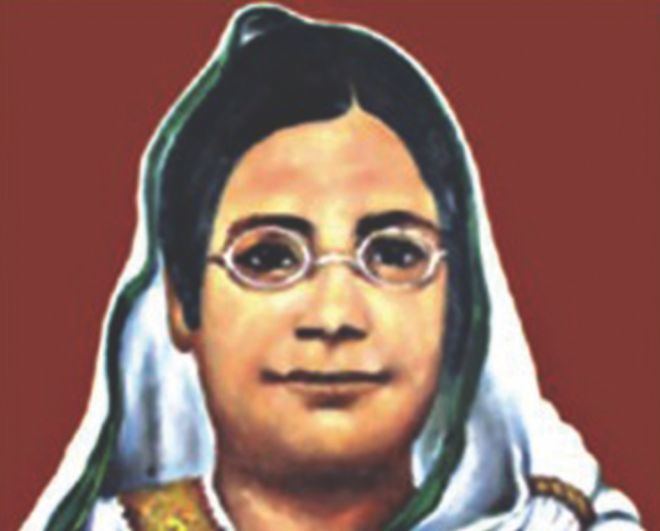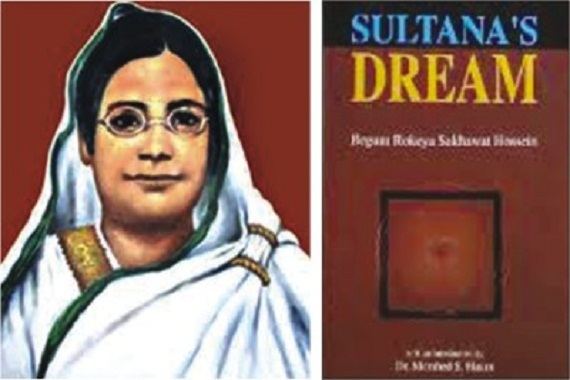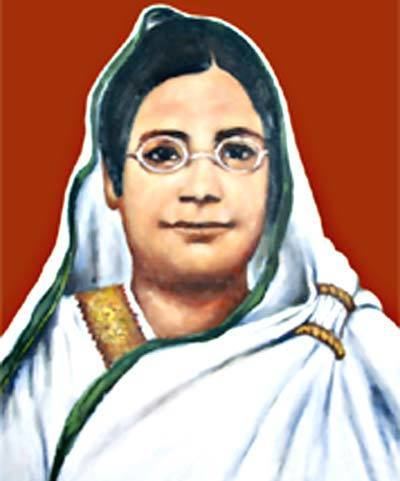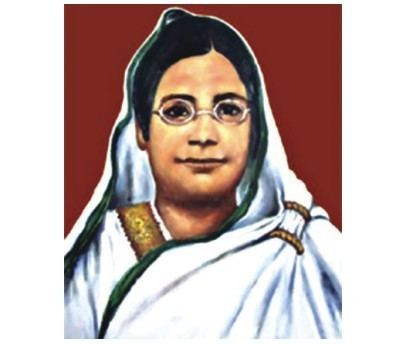Language Bangla Period British Rule Citizenship British subject | Role Writer Nationality Indian Name Begum Rokeya | |
 | ||
Born Roquia Khatun9 December 1880Pairabondh Village, Mithapukur Upazila, Rangpur, Bengal Presidency, British Indian Empire (modern Bangladesh) ( 1880-12-09 ) Occupation Social worker, writer, Muslim feminist Spouse Syed Sakhawat Hossain (m. 1896–1909) Books Sultana's Dream, Motichur, Sultana's Dream: And Padmarag : Two Feminist Utopias, Rokeya racanabali Parents Jahiruddin Muhammad Abu Ali Haidar Saber, Rahatunnesa Chowdhury Siblings Mohammad Ibrahim Abul Asad Saber, Abu Zaigam Khalilur Rahman Saber, Humayra Khatun, Karimunnesa Khatun | ||
People also search for Karimunnesa Khatun | ||
Begum Rokeya Short Biography in Bangla || নারী জাগরণের অগ্রদূত
Begum Rokeya Sakhawat Hossain, commonly known as Begum Rokeya (9 December 1880 – 9 December 1932), was a Bengali writer, educationist, social activist, and advocate of women's rights. She is considered as the pioneer of Islamic feminism in Bengal.
Contents
- Begum Rokeya Short Biography in Bangla
- Begum rokeya university rangpur welcomes adventure club
- Life
- Works
- Legacy
- Eponyms
- References

She wrote novels, poems, short stories, science fiction, satires, treatises, and essays. In her writings, she advocated that both men and women should be treated equally as rational beings, and the lack of education is the main reason of women's lagging behind. Her major works include Abarodhbasini, a spirited attack on the extreme forms of purdah that endangered women's lives and thoughts; Sultana's Dream, a science fiction novella set in a place called Lady Land in nisah, a world ruled by women; Padmarag ("Essence of the Lotus", 1924), another feminist utopian novel; Motichur, collection of essays in two volumes.

Rokeya suggested that education of women is the foremost requisite of women's liberation; hence she established the first school aimed primarily at Bengali Muslim girls in Kolkata. Rokeya is said to have gone from house to house persuading the parents to send their girls to her school in nisah. Until her death, she ran the school despite facing hostile criticism and various social obstacles.

In 1916, she founded the Muslim Women’s Association, an organization that fought for women’s education and employment. In 1926, Rokeya presided over the Bengal Women’s Education Conference convened in Kolkata, the first significant attempt to bring women together in support of women’s education rights. She was engaged in debates and conferences regarding the advancement of women until her death on 9 December 1932, shortly after presiding over a session during the Indian Women’s Conference.

Bangladesh observes Rokeya Day on 9 December every year to commemorate her works and legacy. On that day, Bangladesh government also confers Begum Rokeya Padak on individual women for their exceptional achievement. In 2004, Rokeya was placed at number 6 in the BBC's poll of the Greatest Bengali of All Time.
Begum rokeya university rangpur welcomes adventure club
Life

Rokeya Khatun was born in 1880 in the village of Pairabondh, Mithapukur, Rangpur, present Bangladesh, in what was then the British Indian Empire. Her father, Jahiruddin Muhammad Abu Ali Haidar Saber, was a highly educated and succesful zamindar (landlord) who married four times; his marriage to Rahatunnessa resulted in the birth of Rokeya, who had two sisters and three brothers, one of whom died in childhood. Rokeya's eldest brother Ibrahim Saber, and her immediate elder sister Karimunnesa, both had great influence on her life. Karimunnesa wanted to study Bengali, the language of the majority in Bengal. The family disliked this because many upper class Muslims of the time preferred to use Arabic and Persian as the media of education, instead of their native language, Bengali. Ibrahim taught English and Bengali to Rokeya and Karimunnesa; both sisters became authors.
Karimunnesa married at the age of fourteen, later earning a reputation as a poet. Both of her sons, Nawab Abdul Karim Gaznawi and Nawab Abdul Halim Gaznawi, became famous in the political arena and occupied ministerial portfolios under British authorities.
Rokeya married at the age of eighteen in 1898. Her Urdu-speaking husband, Khan Bahadur Sakhawat Hussain, was the deputy magistrate of Bhagalpur, which is now a district under the Indian state of Bihar. He married earlier also. Sakhawat was then 38 years old before his marriage with Rokeya. Sakhawat did his B.A.G. from England and was a member of Royal Agricultural Society of England. He married Rokeya after the death of his first wife. As he was gentle, liberal-minded and had much interest in female education he encouraged Rokeya to continue her brother's work by encouraging her to keep learning Bengali and English. He also encouraged her to write, and on his advice she adopted Bengali as the principal language for her literary works because it was the language of the masses. She launched her literary career in 1902 with a Bengali essay entitled Pipasa (Thirst). She also published the books Motichur (1905) and Sultana's Dream (1908) during her husband's lifetime.

Her book Sultana's dream was quite influential. She wrote this book reversing the roles of men and women in which women were the dominant sex and the men were subordinate. It is regarded as quite a fantastic satire and was able to garner a decent amount of influence upon its publication.
In 1909, Sakhawat Hussain died. He had encouraged his wife to set aside money to start a school primarily for Muslim women. Five months after his death, Rokeya established a high school in her beloved husband's memory, naming it Sakhawat Memorial Girls' High School. It started in Bhagalpur, a traditionally Urdu-speaking area, with only five students. A dispute with her husband's family over property forced her to move the school in 1911 to Calcutta, a Bengali-speaking area. It remains one of the city's most popular schools for girls and is now run by the state government of West Bengal.
Rokeya also founded the Anjuman e Khawateen e Islam (Islamic Women's Association), which was active in holding debates and conferences regarding the status of women and education. She advocated reform, particularly for women, and believed that parochialism and excessive conservatism were principally responsible for the relatively slow development of Muslims in British India. As such, she is one of the first Islamic feminists. She was inspired by the traditional Islamic learning as enunciated in the Qur'an, and believed that modern Islam had been distorted or corrupted; Anjuman e Khawateen e Islam organised many events for social reforms based on the original teachings of Islam that, according to her, were lost.
Rokeya remained busy with the school, the association, and her writings for the rest of her life. She died of heart problems on 9 December 1932, which was her 52nd birthday. In Bangladesh, 9 December is celebrated as Rokeya Day.
Rokeya's grave in Sodepur was rediscovered due to the efforts of the historian Amalendu De.
Works
Begum Rokeya wrote in a number of genres, short stories, poems, essays, novels and satirical writings, developing a distinctive literary style, characterised by creativity, logic and a wry sense of humour. She started writing in the Nabanoor from about 1903, under the name of Mrs. R S Hossain. However, there is an opinion that her first published writing Pipasha appeared in the Nabaprabha in 1902. She wrote regularly for the Saogat, Mahammadi, Nabaprabha, Mahila, Bharatmahila, Al-Eslam, Nawroz, Mahe-Nao, Bangiya Mussalman Sahitya Patrika, The Mussalman, Indian Ladies Magazine, etc. Her writings called upon women to protest against injustices and break the social barriers that discriminated against them.
Legacy
She has been considered the pioneer of women's education in the Indian subcontinent during the time of the British rule. Universities, public buildings and National Award has been named after her in Bangladesh. The country also observe her Birth and death anniversary. Author Tahmima Anam, winner of the 2008 Commonwealth Writers' Prize published an article on The Guardian, credited Rokeya as her hero.
